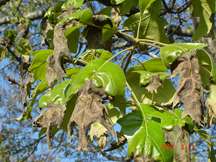Killer freeze of '07 illustrates paradoxes of warming climate

Widespread damage to plants from a sudden freeze that occurred across the Eastern United States from 5 April to 9 April 2007 was made worse because it had been preceded by two weeks of unusual warmth, according to an analysis published in the March 2008 issue of BioScience.
A destructive spring freeze that chilled the eastern United States almost a year ago illustrates the threat a warming climate poses to plants and crops, according to a paper just published in the journal BioScience. The study was led by a team from the Department of Energy's Oak Ridge National Laboratory.
The "Easter freeze" of April 5-9, 2007, blew in on an ill wind. Plants had been sending out young and tender sprouts two to three weeks earlier than normal during an unusually warm March. Plant ecologists, as well as farmers and gardeners, took note of the particularly harsh turn of the weather in early April.
"The warm weather was as much a culprit for the damage as the cold," said lead author Lianhong Gu of ORNL's Environmental Sciences Division.
"We see the paradox in that mild winters and warm, early springs make the plants particularly vulnerable to late-season frosts," Gu said. Gu's team observed satellite images and field data to establish the extent of the 2007 spring freeze. They also assessed the long-term and short-term effects on the terrestrial carbon cycle with respect to plant activity in normal years. Short-term effects were "profound," Gu said.
"In the period just after the freeze we saw a large reduction in the fraction of absorbed photosynthetically active radiation, which is a sensitive indicator of plant growth," he said. "We also noted that the regrowth in the following weeks and months did not result in the levels of plant development in previous years."
Gu's team hypothesized that the freeze could have long-term effects on forest carbon uptake because of damage the cold did to the prematurely developed plant tissues, which could affect future growing seasons. The associated carbon and nutrient losses may affect growth in future years.
Beyond devastated horticultural crops, the study noted that some species suffered more than others. Yellow poplar trees were "surprisingly" slow to put out flushes of new leaves, and white oaks were particularly hard hit with freeze damage to both new leaves and flowers. On the other hand, trees located along shorelines--where the water stores heat--and underneath dense canopies seemed to be protected from the cold.
Compounding the stress on plants, as noted in the International Panel on Climate Change's fourth assessment report, is the prospect of prolonged droughts, which also occurred in the region last summer.
"This freeze should not be viewed as an isolated event; rather, it represents a realistic climate change scenario that has long concerned plant ecologists," Gu said.
Authors on the paper include Gu, Paul Hanson, Dale Kaiser, Mac Post and Bai Yang of ORNL; Ramakrishna Nemani of NASA's Ames Research Center; Stephen G. Pallardy of the University of Missouri at Columbia, and Tilden Meyers of the National Oceanic and Atmospheric Administration's Air Resources Laboratory in Oak Ridge. The DOE Office of Science's Biological and Environmental Research program funded the studies.
Source: ORNL




















